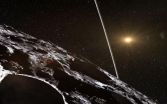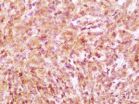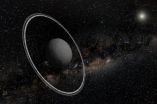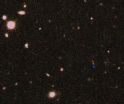(Press-News.org) The rings of Saturn are one of the most spectacular sights in the sky, and less prominent rings have also been found around the other giant planets. Despite many careful searches, no rings had been found around smaller objects orbiting the Sun in the Solar System. Now observations of the distant minor planet [1] (10199) Chariklo [2] as it passed in front of a star have shown that this object too is surrounded by two fine rings.
"We weren't looking for a ring and didn't think small bodies like Chariklo had them at all, so the discovery — and the amazing amountof detail we saw in the system — came as a complete surprise!" says Felipe Braga-Ribas (Observatório Nacional/MCTI, Rio de Janeiro, Brazil) who planned the observation campaign and is lead author on the new paper.
Chariklo is the largest member of a class known as the Centaurs [3] and it orbits between Saturn and Uranus in the outer Solar System. Predictions had shown that it would pass in front of the star UCAC4 248-108672 on 3 June 2013, as seen from South America [4]. Astronomers using telescopes at seven different locations, including the 1.54-metre Danish and TRAPPIST telescopes at ESO's La Silla Observatory in Chile [5], were able to watch the star apparently vanish for a few seconds as its light was blocked by Chariklo — an occultation [6].
But they found much more than they were expecting. A few seconds before, and again a few seconds after the main occultation there were two further very short dips in the star's apparent brightness [7]. Something around Chariklo was blocking the light! By comparing what was seen from different sites the team could reconstruct not only the shape and size of the object itself but also the shape, width, orientation and other properties of the newly discovered rings.
The team found that the ring system consists of two sharply confined rings only seven and three kilometres wide, separated by a clear gap of nine kilometres — around a small 250-kilometre diameter object orbiting beyond Saturn.
"For me, it was quite amazing to realise that we were able not only to detect a ring system, but also pinpoint that it consists of two clearly distinct rings," adds Uffe Gråe Jørgensen (Niels Bohr Institute, University of Copenhagen, Denmark), one of the team. "I try to imagine how it would be to stand on the surface of this icy object — small enough that a fast sports car could reach escape velocity and drive off into space — and stare up at a 20-kilometre wide ring system 1000 times closer than the Moon." [8]
Although many questions remain unanswered, astronomers think that this sort of ring is likely to be formed from debris left over after a collision. It must be confined into the two narrow rings by the presence of small putative satellites.
"So, as well as the rings, it's likely that Chariklo has at least one small moon still waiting to be discovered," adds Felipe Braga Ribas.
The rings may prove to be a phenomenon that might in turn later lead to the formation of a small moon. Such a sequence of events, on a much larger scale, may explain the birth of our own Moon in the early days of the Solar System, as well as the origin of many other satellites around planets and asteroids.
The leaders of this project are provisionally calling the rings by the nicknames Oiapoque and Chuí, two rivers near the northern and southern extremes of Brazil [9].
INFORMATION:
Notes
[1] All objects that orbit the Sun, which are too small (not massive enough) for their own gravity to pull them into a nearly spherical shape are now defined by the IAU as being small solar system bodies. This class currently includes most of the Solar System asteroids, near-Earth objects (NEOs), Mars and Jupiter Trojan asteroids, most Centaurs, most Trans-Neptunian objects (TNOs), and comets. In informal usage the words asteroid and minor planet are often used to mean the same thing.
[2] The IAU Minor Planet Center is the nerve centre for the detection of small bodies in the Solar System. The names assigned are in two parts, a number — originally the order of discovery but now the order in which orbits are well-determined — and a name.
[3] Centaurs are small bodies with unstable orbits in the outer Solar System that cross the orbits of the giant planets. Because their orbits are frequently perturbed they are expected to only remain in such orbits for millions of years. Centaurs are distinct from the much more numerous main belt asteroids between the orbits of Mars and Jupiter and may have come from the Kuiper Belt region. They got their name because — like the mythical centaurs — they share some characteristics of two different things, in this case comets and asteroids. Chariklo itself seems to be more like an asteroid and has not been found to display cometary activity.
[4] The event was predicted following a systematic search conducted with the MPG/ESO 2.2-metre telescope at ESO's La Silla Observatory and recently published.
[5] Besides the Danish 1.54-metre and TRAPPIST telescopes at ESO's La Silla Observatory, event observations were also performed by the following observatories: Universidad Católica Observatory (UCO) Santa Martina operated by the Pontifícia Universidad Católica de Chile (PUC); PROMPT telescopes, owned and operated by the University of North Carolina at Chapel Hill; Pico dos Dias Observatory from the National Laboratory of Astrophysics (OPD/LNA) - Brazil; Southern Astrophysical Research (SOAR) telescope; Caisey Harlingten's 20-inch Planewave telescope, which is part of the Searchlight Observatory Network; R. Sandness's telescope at San Pedro de Atacama Celestial Explorations; Universidade Estadual de Ponta Grossa Observatory; Observatorio Astronomico Los Molinos (OALM) — Uruguay; Observatorio Astronomico, Estacion Astrofisica de Bosque Alegre, Universidad Nacional de Cordoba, Argentina; Polo Astronômico Casimiro Montenegro Filho Observatory and Observatorio El Catalejo, Santa Rosa, La Pampa, Argentina.
[6] This is the only way to pin down the precise size and shape of such a remote body — Chariklo is only about 250 kilometres in diameter and is more than a billion kilometres from Earth. Even in the best telescopic views such a small and distant object just appears as a faint point of light.
[7] The rings of Uranus, and the ring arcs around Neptune, were found in a similar way during occultations in 1977 and 1984, respectively. ESO telescopes were also involved with the Neptune ring discovery.
[8] Strictly speaking the car would have to be rather fast — something like a Bugatti Veyron 16.4 or McLaren F1 — asthe escape velocity is around 350 km/hour!
[9] These names are only for informal use, the official names will be allocated later by the IAU, following pre-established rules.
More information
This research was presented in a paper entitled "A ring system detected around the Centaur (10199) Chariklo", by F. Braga-Ribas et al., to appear online in the journal Nature on 26 March 2014.
The team is composed of F. Braga-Ribas (Observatório Nacional/MCTI, Rio de Janeiro, Brazil), B. Sicardy (LESIA, Observatoire de Paris, Paris, France [LESIA]), J. L. Ortiz (Instituto de Astrofísica de Andalucía, Granada, Spain), C. Snodgrass (Max Planck Institute for Solar System Research, Katlenburg-Lindau, Germany), F. Roques (LESIA), R. Vieira- Martins (Observatório Nacional/MCTI, Rio de Janeiro, Brazil; Observatório do Valongo, Rio de Janeiro, Brazil; Observatoire de Paris, France), J. I. B. Camargo (Observatório Nacional/MCTI, Rio de Janeiro, Brazil), M. Assafin (Observatório do Valongo/UFRJ, Rio de Janeiro, Brazil), R. Duffard (Instituto de Astrofísica de Andalucía, Granada, Spain), E. Jehin (Institut d'Astrophysique de l'Université de Liege, Liege, Belgium), J. Pollock (Appalachian State University, Boone, North Carolina, USA), R. Leiva (Pontificia Universidad Católica de Chile, Santiago, Chile), M. Emilio (Universidade Estadual de Ponta Grossa, Ponta Grossa, Brazil), D. I. Machado (Polo Astronomico Casimiro Montenegro Filho/FPTI-BR, Foz do Iguaçu, Brazil; Universidade Estadual do Oeste do Paraná (Unioeste), Foz do Iguaçu, Brazil), C. Colazo (Ministerio de Educación de la Provincia de Córdoba, Córdoba, Argentina; Observatorio Astronómico, Universidad Nacional de Córdoba, Córdoba, Argentina), E. Lellouch (LESIA), J. Skottfelt (Niels Bohr Institute, University of Copenhagen, Copenhagen, Denmark; Centre for Star and Planet Formation, Geological Museum, Copenhagen, Denmark), M. Gillon (Institut d'Astrophysique de l'Université de Liege, Liege, Belgium), N. Ligier (LESIA), L. Maquet (LESIA), G. Benedetti-Rossi (Observatório Nacional/MCTI, Rio de Janeiro, Brazil), A. Ramos Gomes Jr (Observatório do Valongo, Rio de Janeiro, Brazil, P. Kervella (LESIA), H. Monteiro (Instituto de Física e Química, Itajubá, Brazil), R. Sfair (UNESP -– Univ Estadual Paulista, Guaratinguetá, Brazil), M. El Moutamid (LESIA; Observatoire de Paris, Paris, France), G. Tancredi (Observatorio Astronomico Los Molinos, DICYT, MEC, Montevideo, Uruguay; Dpto. Astronomia, Facultad Ciencias, Uruguay), J. Spagnotto (Observatorio El Catalejo, Santa Rosa, La Pampa, Argentina), A. Maury (San Pedro de Atacama Celestial Explorations, San Pedro de Atacama, Chile), N. Morales (Instituto de Astrofísica de Andalucía, Granada, Spain), R. Gil-Hutton (Complejo Astronomico El Leoncito (CASLEO) and San Juan National University, San Juan, Argentina), S. Roland (Observatorio Astronomico Los Molinos, DICYT, MEC, Montevideo, Uruguay), A. Ceretta (Dpto. Astronomia, Facultad Ciencias, Uruguay; Observatorio del IPA, Ensenanza Secundaria, Uruguay), S.-h. Gu (National Astronomical Observatories/Yunnan Observatory; Key Laboratory for the Structure and Evolution of Celestial Objects, Chinese Academy of Sciences, Kunming, China), X.-b. Wang (National Astronomical Observatories/Yunnan Observatory; Key Laboratory for the Structure and Evolution of Celestial Objects, Chinese Academy of Sciences, Kunming, China), K. Harpsøe (Niels Bohr Institute, University of Copenhagen, Copenhagen, Denmark; Centre for Star and Planet Formation, Geological Museum, Copenhagen, Denmark), M. Rabus (Pontificia Universidad Católica de Chile, Santiago, Chile; Max Planck Institute for Astronomy, Heidelberg, Germany), J. Manfroid (Institut d'Astrophysique de l'Université de Liege, Liege, Belgium), C. Opitom (Institut d'Astrophysique de l'Université de Liege, Liege, Belgium), L. Vanzi (Pontificia Universidad Católica de Chile, Santiago, Chile), L. Mehret (Universidade Estadual de Ponta Grossa, Ponta Grossa, Brazil), L. Lorenzini (Polo Astronomico Casimiro Montenegro Filho/FPTI-BR, Foz do Iguaçu, Brazil), E. M. Schneiter (Observatorio Astronómico, Universidad Nacional de Córdoba, Córdoba, Argentina; Consejo Nacional de Investigaciones Científicas y Técnicas (CONICET), Argentina; Instituto de Astronomía Teórica y Experimental IATE–CONICET, Córdoba, Argentina; Universidad Nacional de Córdoba, Córdoba, Argentina), R. Melia (Observatorio Astronómico, Universidad Nacional de Córdoba, Córdoba, Argentina), J. Lecacheux (LESIA), F. Colas (Observatoire de Paris, Paris, France), F. Vachier (Observatoire de Paris, Paris, France), T. Widemann (LESIA), L. Almenares (Observatorio Astronomico Los Molinos, DICYT, MEC, Montevideo, Uruguay; Dpto. Astronomia, Facultad Ciencias, Uruguay), R. G. Sandness (San Pedro de Atacama Celestial Explorations, San Pedro de Atacama, Chile), F. Char (Universidad de Antofagasta, Antofagasta, Chile), V. Perez (Observatorio Astronomico Los Molinos, DICYT, MEC, Montevideo, Uruguay; Dpto. Astronomia, Facultad Ciencias, Uruguay), P. Lemos (Dpto. Astronomia, Facultad Ciencias, Uruguay), N. Martinez (Observatorio Astronomico Los Molinos, DICYT, MEC, Montevideo, Uruguay; Dpto. Astronomia, Facultad Ciencias, Uruguay), U. G. Jørgensen (Niels Bohr Institute, University of Copenhagen, Copenhagen, Denmark; Centre for Star and Planet Formation, Geological Museum, Copenhagen, Denmark), M. Dominik (University of St Andrews, St Andrews, United Kingdom) F. Roig (Observatório Nacional/MCTI, Rio de Janeiro, Brazil), D. E. Reichart (University of North Carolina – Chapel Hill, North Carolina [UNC]), A. P. LaCluyze (UNC), J. B. Haislip (UNC), K. M. Ivarsen (UNC), J. P. Moore (UNC), N. R. Frank (UNC) and D. G. Lambas (Observatorio Astronómico, Universidad Nacional de Córdoba, Córdoba, Argentina; Instituto de Astronomía Teórica y Experimental IATE–CONICET, Córdoba, Argentina).
ESO is the foremost intergovernmental astronomy organisation in Europe and the world's most productive ground-based astronomical observatory by far. It is supported by 15 countries: Austria, Belgium, Brazil, the Czech Republic, Denmark, France, Finland, Germany, Italy, the Netherlands, Portugal, Spain, Sweden, Switzerland and the United Kingdom. ESO carries out an ambitious programme focused on the design, construction and operation of powerful ground-based observing facilities enabling astronomers to make important scientific discoveries. ESO also plays a leading role in promoting and organising cooperation in astronomical research. ESO operates three unique world-class observing sites in Chile: La Silla, Paranal and Chajnantor. At Paranal, ESO operates the Very Large Telescope, the world's most advanced visible-light astronomical observatory and two survey telescopes. VISTA works in the infrared and is the world's largest survey telescope and the VLT Survey Telescope is the largest telescope designed to exclusively survey the skies in visible light. ESO is the European partner of a revolutionary astronomical telescope ALMA, the largest astronomical project in existence. ESO is currently planning the 39-metre European Extremely Large optical/near-infrared Telescope, the E-ELT, which will become "the world's biggest eye on the sky".
Links
Research paper in Nature
Photos of the Danish 1.54-metre telescope
Photos of TRAPPIST
Contacts
Felipe Braga-Ribas
Observatório Nacional/MCTI
Rio de Janeiro, Brazil
Tel: +33 (0) 785944776 (until 28.3) and +55 (21) 3504-9252
Cell: +55 (21) 983803879 (after 28.3)
Email: ribas@on.br
Bruno Sicardy
LESIA, Observatoire de Paris, CNRS
Paris, France
Tel: +33 (0) 1 45 07 71 15
Cell: +33 (0) 6 19 41 26 15
Email: bruno.sicardy@obspm.fr
José Luis Ortiz
Instituto de Astrofísica de Andalucía, CSIC
Granada, Spain
Tel: +34 958 121 311
Email: ortiz@iaa.es
Richard Hook
ESO Public Information Officer
Garching bei München, Germany
Tel: +49 89 3200 6655
Cell: +49 151 1537 3591
Email: rhook@eso.org
First ring system around asteroid
Chariklo found to have 2 rings
2014-03-26
ELSE PRESS RELEASES FROM THIS DATE:
Gut metabolism changes -- not stomach size -- linked to success of vertical sleeve gastrectomy
2014-03-26
CINCINNATI—It's not the size of the stomach that causes weight loss after a specific type of bariatric surgery, but rather a change in the gut metabolism, say researchers from the University of Cincinnati (UC), the University of Gothenburg in Sweden and Cincinnati Children's Hospital Medical Center.
The scientists, publishing their results in the March 26, 2014, advanced online edition of Nature, have found that following vertical sleeve gastrectomy, there is a change in bile acids that bind to a nuclear receptor called FXR. In the absence of FXR, the researchers showed, ...
Some breast cancer tumors hijack patient epigenetic machinery to evade drug therapy
2014-03-26
PITTSBURGH, March 26, 2014 – A breast cancer therapy that blocks estrogen synthesis to activate cancer-killing genes sometimes loses its effectiveness because the cancer takes over epigenetic mechanisms, including permanent DNA modifications in the patient's tumor, once again allowing tumor growth, according to an international team headed by the University of Pittsburgh Cancer Institute (UPCI).
The finding warrants research into adding drugs that could prevent the cancer from hijacking patients' repressive gene regulatory machinery, which might allow the original therapy ...
First comprehensive atlas of human gene activity released
2014-03-26
Boston, MA — A large international consortium of researchers has produced the first comprehensive, detailed map of the way genes work across the major cells and tissues of the human body. The findings describe the complex networks that govern gene activity, and the new information could play a crucial role in identifying the genes involved with disease.
"Now, for the first time, we are able to pinpoint the regions of the genome that can be active in a disease and in normal activity, whether it's in a brain cell, the skin, in blood stem cells or in hair follicles," said ...
Brain degeneration in Huntington's disease caused by amino acid deficiency
2014-03-26
Working with genetically engineered mice, Johns Hopkins neuroscientists report they have identified what they believe is the cause of the vast disintegration of a part of the brain called the corpus striatum in rodents and people with Huntington's disease: loss of the ability to make the amino acid cysteine. They also found that disease progression slowed in mice that were fed a diet rich in cysteine, which is found in foods such as wheat germ and whey protein.
Their results suggest further investigation into cysteine supplementation as a candidate therapeutic in people ...
Cosmic collision creates mini-planet with rings
2014-03-26
Until now, rings of material in a disc have only been observed around giant planets like Jupiter, Uranus, Neptune and especially Saturn, which is known for its spectacular rings. Now astronomers from the Niels Bohr Institute, among others, have observed the first miniature planet with two rings of ice and pebbles. It is a smaller celestial body, called Chariklo, located two billion kilometers out in the solar system between Saturn and Uranus. The results are published in the prestigious scientific journal, Nature.
Chariklo was located in the Kuiper Belt, a collection ...
New maps for navigating the genome unveiled by scientists
2014-03-26
Scientists have built the clearest picture yet of how our genetic material is regulated in order to make the human body work.
They have mapped how a network of switches, built into our DNA, controls where and when our genes are turned on and off.
University of Edinburgh scientists played a leading role in the international project – called FANTOM5 – which has been examining how our genome holds the code for creating the fantastic diversity of cell types that make up a human.
The three year project, steered by the RIKEN Center for Life Science Technologies in Japan, ...
Keeping secrets in a world of spies and mistrust
2014-03-26
VIDEO:
This is an interview with Professor Artur Ekert, co-inventor of quantum cryptography, about what it takes to keep secrets secret.
Click here for more information.
Revelations of the extent of government surveillance have thrown a spotlight on the security – or lack thereof – of our digital communications. Even today's encrypted data is vulnerable to technological progress. What privacy is ultimately possible? In the 27 March issue of Nature, the weekly international ...
Cell-saving drugs could reduce brain damage after stroke
2014-03-26
Long-term brain damage caused by stroke could be reduced by saving cells called pericytes that control blood flow in capillaries, reports a new study led by scientists from UCL (University College London).
Until now, many scientists believed that blood flow within the brain was solely controlled by changes in the diameter of arterioles, blood vessels that branch out from arteries into smaller capillaries. The latest research reveals that the brain's blood supply is in fact chiefly controlled by the narrowing or widening of capillaries as pericytes tighten or loosen around ...
Should whole-genome sequencing become part of newborn screening?
2014-03-26
That question is likely to stir debate in coming years in many of the more-than-60 countries that provide newborn screening, as whole-genome sequencing (WGS) becomes increasingly affordable and reliable. Newborn screening programs – which involve drawing a few drops of blood from a newborn's heel – have been in place since the late 1960s, and are credited with having saved thousands of lives by identifying certain genetic, endocrine or metabolic disorders that can be treated effectively when caught early enough. Advocates of routine WGS for newborns argue that the new technology ...
Solar System's edge redefined
2014-03-26
Washington, D.C.—The Solar System has a new most-distant member, bringing its outer frontier into focus.
New work from Carnegie's Scott Sheppard and Chadwick Trujillo of the Gemini Observatory reports the discovery of a distant dwarf planet, called 2012 VP113, which was found beyond the known edge of the Solar System. This is likely one of thousands of distant objects that are thought to form the so-called inner Oort cloud. What's more, their work indicates the potential presence of an enormous planet, perhaps up to 10 times the size of Earth, not yet seen, but possibly ...
LAST 30 PRESS RELEASES:
Numbers in our sights affect how we perceive space
SIMJ announces global collaborative book project in commemoration of its 75th anniversary
Air pollution exposure and birth weight
Obstructive sleep apnea risk and mental health conditions among older adults
How talking slows eye movements behind the wheel
The Ceramic Society of Japan’s Oxoate Ceramics Research Association launches new international book project
Heart-brain connection: international study reveals the role of the vagus nerve in keeping the heart young
Researchers identify Rb1 as a predictive biomarker for a new therapeutic strategy in some breast cancers
Survey reveals ethical gaps slowing AI adoption in pediatric surgery
Stimulant ADHD medications work differently than thought
AI overestimates how smart people are, according to HSE economists
HSE researchers create genome-wide map of quadruplexes
Scientists boost cell "powerhouses" to burn more calories
Automatic label checking: The missing step in making reliable medical AI
Low daily alcohol intake linked to 50% heightened mouth cancer risk in India
American Meteorological Society announces Rick Spinrad as 2026 President-Elect
Biomass-based carbon capture spotlighted in newly released global climate webinar recording
Illuminating invisible nano pollutants: advanced bioimaging tracks the full journey of emerging nanoscale contaminants in living systems
How does age affect recovery from spinal cord injury?
Novel AI tool offers prognosis for patients with head and neck cancer
Fathers’ microplastic exposure tied to their children’s metabolic problems
Research validates laboratory model for studying high-grade serous ovarian cancer
SIR 2026 delivers transformative breakthroughs in minimally invasive medicine to improve patient care
Stem Cell Reports most downloaded papers of 2025 highlight the breadth and impact of stem cell research
Oxford-led study estimates NHS spends around 3% of its primary and secondary care budget on the health impacts of heat and cold in England
A researcher’s long quest leads to a smart composite breakthrough
Urban wild bees act as “microbial sensors” of city health.
New study finds where you live affects recovery after a hip fracture
Forecasting the impact of fully automated vehicle adoption on US road traffic injuries
Alcohol-related hospitalizations from 2016 to 2022
[Press-News.org] First ring system around asteroidChariklo found to have 2 rings




